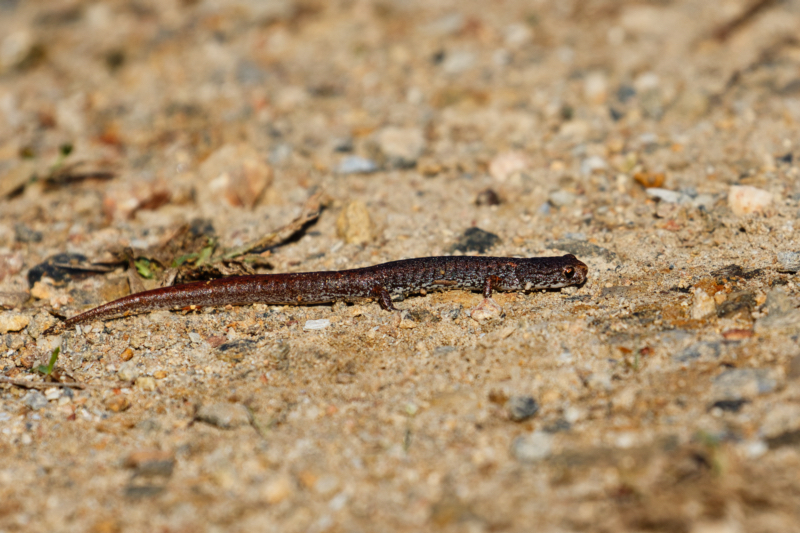While walking along a quiet country road near the Ouachita National Forest in Arkansas, I was lucky to come across a tiny creature I had never seen before—a Four-toed Salamander! At first glance, I wasn’t sure what kind of amphibian I was looking at, but after a little research, I identified it as a Four-toed Salamander (Hemidactylium scutatum).
This encounter was an exciting one for me as a wildlife photographer because it’s not every day that you get to see such a unique amphibian. Naturally, I took out my camera, got down low to the ground, and handheld my lens to capture some detailed shots without disturbing it. After learning more about this species, I couldn’t wait to share some of the fascinating facts I uncovered!

Meet the Four-toed Salamander
The Four-toed Salamander is native to the eastern United States and belongs to the family of lungless salamanders. That’s right—this little creature breathes entirely through its skin! Instead of laying eggs in water like many other salamanders, it lays its eggs on land. Its name comes from the fact that it has only four toes on its hind feet, whereas most salamanders have five.
This species is a joy to photograph not only because of its unusual appearance but also because it plays a helpful role in the environment. For example, I learned that Four-toed Salamanders eat ticks—an especially welcome fact for anyone who spends time in areas like the Ouachita National Forest, where ticks can be a problem.
Unique Physical Traits and Behaviors
These tiny creatures are quite small, measuring only 2 to 3.5 inches long, making them one of the smallest terrestrial vertebrates in the Northeast. One of their most unique features is a distinct constriction at the base of their tail, which allows the tail to break off easily if they’re grabbed by a predator—a clever survival tactic!
The salamander I found was near a forested area with plenty of moss, which makes sense because these salamanders prefer mature forests with nearby wetlands for breeding. Their ideal habitat often includes sphagnum moss, which plays a crucial role in their nesting behavior. They use this moss to lay eggs in, and it’s fascinating to know that multiple females may share the same nest, with up to 800 eggs in one communal spot!
Ecological Importance and Conservation
Despite their small size, Four-toed Salamanders are vital to the health of forest ecosystems. They feed on small invertebrates, including calcium-rich prey like spiders and insects, which in turn makes them an important food source for predators like shrews, snakes, and birds. Their presence helps to maintain the delicate balance of nutrient cycling and energy flow within the forest.
Unfortunately, like many species, they face conservation challenges. Habitat loss and fragmentation are significant threats, and in some areas, such as Vermont, they are listed as a species of special concern.
A Special Wildlife Moment
Coming across this Four-toed Salamander was a special moment for me. Part of the joy of nature photography is that it leads you to unexpected discoveries, encouraging you to slow down, observe, and appreciate even the smallest creatures. I’m glad I took the time to identify and learn about this salamander and its role in the ecosystem.
Let me know in the comments if you’ve ever spotted a Four-toed Salamander, or if you’ve encountered any other fascinating wildlife on your outdoor adventures!
Interesting Facts About Four-toed Salamanders:
- Size: These salamanders are small, usually 2–3.5 inches long.
- Toes: They have only four toes on their hind feet, unlike most salamanders, which have five.
- Tail: Their tail can detach easily if caught by a predator and can regrow later.
- Habitat: They prefer mature forests with nearby wetlands and are often found in areas rich with moss.
- Nesting: Females lay eggs in moss clumps above water and may share nests with other females.
- Breathing: As lungless salamanders, they breathe entirely through their skin.
- Predators and Prey: They eat invertebrates, including ticks, making them beneficial to have around!
I hope you enjoyed learning about this wonderful little amphibian! Whether you’re an experienced wildlife enthusiast or just love exploring nature, it’s always exciting to learn something new.
